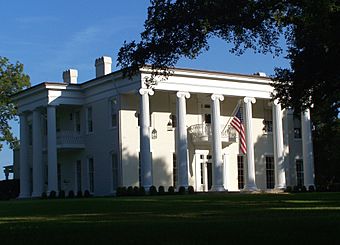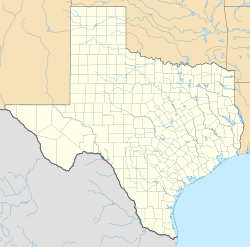Old West Austin Historic District facts for kids
Quick facts for kids |
|
|
Old West Austin Historic District and Boundary Increase
|
|

Woodlawn, the oldest home in the district
|
|
| Location | Austin, Texas |
|---|---|
| Area | 6500 acres |
| Built | 1853 |
| NRHP reference No. | 03000937; 03001413 |
| Added to NRHP | September 12, 2003; January 16, 2004 |
The Old West Austin Historic District is a special neighborhood area in Austin, Texas, United States. It's made up of three smaller neighborhoods: Old Enfield, Pemberton Heights, and Bryker Woods. These areas are located on a flat piece of land just west of downtown Austin.
These neighborhoods were built between 1886 and 1953. They stretch from the Mopac Expressway in the west to Lamar Boulevard in the east. They also go from 13th Street in the south to 35th Street in the north. The district is next to the Clarksville Historic District and the West Line Historic District to the south.
While streetcars helped Austin grow earlier, Enfield, Pemberton Heights, and Bryker Woods were the city's first neighborhoods designed for cars. This historic district shows how suburban areas slowly grew as the city got bigger. All three neighborhoods that form Old West Austin were added to the National Register of Historic Places in 2003. This means they are recognized as important historical places.
Contents
How Old West Austin Started
For much of the 1800s, Shoal Creek and West Avenue marked the western edge of Austin. The city was originally planned on a 640-acre site. This area was on a hill above the Colorado River, between Shoal Creek to the west and Waller Creek to the east. Edwin Waller planned the city in 1839.
The story of Old West Austin begins with its oldest and most famous home, Woodlawn. James B. Shaw, an Irish immigrant, bought hundreds of acres of land west of Austin in 1846. He worked for the Texas government as the State Comptroller.
Shaw hired Austin architect Abner Cook to build a large, two-story Greek Revival style house. The house was finished in 1853. This was one year before Cook built the Texas Governor's Mansion. Shaw decided not to live there due to sad family events. In 1856, Governor Elisha M. Pease bought Woodlawn. His family owned it for almost 50 years. The land around Woodlawn was later sold and divided to create the Enfield neighborhood.
After the American Civil War, Governor Pease sold and gave some of his land to people who had been enslaved. In 1871, this nearby area became known as Clarksville. It was specifically set aside for these freed African Americans.
It was named Clarksville because Charles (Griffin) Clark bought a 365-acre piece of land from former enslaved people. He then started the town of Clarksville, less than half a mile from Woodlawn.
Other important developments in West Austin during the 1870s included the International and Great Northern Railroad. This railroad now forms the western border of the historic district. Also, Pease Park was established. The Pease family donated this land to the city. Shoal Creek runs through Pease Park and was a popular spot for fun activities even in the mid-1800s.
Old Enfield Neighborhood
Old Enfield is the oldest and southernmost neighborhood in the historic district. Its borders are roughly Windsor Road to the north, Pease Park to the east, 13th Street to the south, and the Mo-Pac Expressway to the west. This area was originally part of the Pease family's large property.
In 1910, the Enfield Realty and Home Building Company divided the land into smaller lots. Old Enfield has many of Austin's oldest colonial style homes. This includes Woodlawn, which was built by Texas Governor's Mansion architect Abner Cook.
More parts were added to Old Enfield between 1914 and 1948. Two more additions were made on the west side after 1948. The design of Old Enfield is still mostly the same. It includes several small parks along curved streets near Pease Park.
Pemberton Heights Neighborhood
Just north of Old Enfield is the neighborhood of Pemberton Heights. Judge John Harris bought the land for Pemberton Heights in 1858. He was the attorney general for Governor Pease. S.W. Fisher, who led the Austin Development Company, later owned and developed the land.
The neighborhood was named after James Pemberton, an ancestor of the Fisher family. He was known for his political ideas during the time of the American colonies. The Fisher family inherited the land and started the Austin Land Company. In 1927, the company built a bridge over Shoal Creek and began building homes.
Pemberton Heights was developed in 12 sections between 1927 and the early 1940s. Most homes in Pemberton Heights are one or two stories and for single families. They are generally the largest houses with the biggest yards in the Old West Austin Historic District.
More than 25 buildings in Pemberton Heights are recognized as Austin Historic Landmarks. This includes the Windsor Road Bridge, built in 1928. This bridge is important not just for its design, but also because it made it easier for people in Pemberton Heights to get downtown. Before it was built, they had to cross Shoal Creek on a different bridge, which is now only for people walking.
Bryker Woods Neighborhood
Bryker Woods is the northernmost neighborhood in the Old West Austin Historic District. This area includes several pieces of land that were divided into lots between 1886 and 1951. Bryker Woods saw a lot of building activity between 1936 and 1940.
In the late 1990s, the State of Texas began looking into making the Mopac Expressway bigger. By 2000, the Bryker Woods, Pemberton Heights, and Old Enfield neighborhoods worked together. They were worried that expanding the highway might mean tearing down as many as 80 houses.
In 2003, they successfully created the Old West Austin Historic District. This historic status is very important. It means that if the government uses federal money for a project that could damage properties in the district, they have to do extra studies and get special approval. This adds a lot of time and cost to such projects. Because federal money was needed for the Mopac Expressway expansion, this historic status stopped the highway from expanding further into these neighborhoods.
Important Properties in Old West Austin
The Old West Austin Historic District has about 1,574 properties that are historically important. Several homes and sites in the district have been named historic Austin landmarks by the city. These include:
- Ethel Felder Webster House
- Fisher-Gideon House (also known as Pemberton Castle)
- Splitrock (Austin, Texas)
- Judge Robert Lynn Batts House
- Cruchon Home



